new posts in all blogs
Viewing: Blog Posts Tagged with: San Antonio, Most Recent at Top [Help]
Results 1 - 11 of 11
How to use this Page
You are viewing the most recent posts tagged with the words: San Antonio in the JacketFlap blog reader. What is a tag? Think of a tag as a keyword or category label. Tags can both help you find posts on JacketFlap.com as well as provide an easy way for you to "remember" and classify posts for later recall. Try adding a tag yourself by clicking "Add a tag" below a post's header. Scroll down through the list of Recent Posts in the left column and click on a post title that sounds interesting. You can view all posts from a specific blog by clicking the Blog name in the right column, or you can click a 'More Posts from this Blog' link in any individual post.
Similarly, Latino authors likely know a lot more about Anglos than Anglos do about us. This regularly plays out in some Latino literature's Anglo characters. This brings to mind growing up in San Antonio decades ago, and how Anglos gradually worked their way into my life. Although mine is no template for the "Chicano lifestyle," here's how it taught me the first things I learned about Anglos.
 |
| A highway like this "improved" my 1st neighborhood |
Given the decrepitude of ageing, I don't remember most of the names, but the first one was a neighborhood kid my age, maybe five. He came over regularly and taught me that playing "cowboys and Indians" was fun. Ignorant of the fact that I was part "Indian," we'd ride around the dirt yard on our stick horses, shooting at each other, falling down, and getting dirty. I sort of remember sometimes getting to be the cowboy. He taught me that some Anglos would play with me.
The next ones were female teachers, first through third grade. They were mostly nice, even if I don't remember what I learned from them. Before entering first grade, mi 'amá had already taught me to read, so I assume I picked up whatever math and writing I was supposed to learn because I kept passing to the next grade. The teachers taught me that teachers were Anglo women.
Two incidents in elementary school stick out in my mind. The first was halfway through first grade. Our teacher announced that three of us were being skipped into higher grades. This one poor white boy who could've been twelve years old--the biggest, burliest kid--was being "skipped" to third grade, which was probably still less than age-appropriate for him. I remember thinking the teacher just wanted him gone from her room. From him I learned there were Anglos were much less intelligent than me, even if they were bigger, older and meaner.
Then our teacher announced that two of us--I think the other one was named Judy--were skipping into second grade. That meant something to other kids, my parents, relatives, and the teacher, but I don't remember being impressed by this, since I didn't know what it meant.
Judy gave me another memory, of dancing. During one of those school activities everyone had to participate in, maybe May Day. Out on the playground, we were all paired up and for some reason, nerd-brain, skinny, too-tall, blond Judy got paired up with the shortest kid--a "Mexican" as we called ourselves--who was me. I faked it, going around in circles, thinking I it was supposed to be having fun. Though, not as much fun as getting to be the cowboy. From Judy, I learned Anglo girls would at times be willing to hold my hand, at least in public.
 |
| San Anto was the military's playground |
Next came my uncle Jack, a military-lifer who later married my mother's sister. He was real white, tall and big, loud and always made his presence known. Whenever the couple came by our house was a treat, probably because their income was higher than most of the family. Before they had any of their own kids, Uncle Jack would take me out while he courted my aunt. The best time was a zoo visit where I got to eat lots of junk because he could afford it. He taught me the military had it much better than most people, though maybe his Anglo-ness had something to do with his good fortune.
 |
| Projects like where we lived |
About my age, Mary B. didn't teach me as much as I'd have liked. In the federal projects where we lived, her family was one of the few Anglo families around. She had an older sister who was a template for juvenile delinquency, and sort of respected by all the younger kids. Whenever they let her out of juvey or prison, she'd visit with her latest tattooed boyfriend who also looked like he was on parole. They taught me there were tough, young Anglos in the world, whenever they were let out.
 |
| Marie B's were shorter than this |
Mary B. could've been my first love, or at least experience, except that never happened. She was hotter than her older sister and usually wore shorts that couldn't have been cut any shorter. Neighborhood culture dictated she was unapproachable because she was white, something I didn't understand. For my only teen birthday party I can remember, I invited her and, chingau, she showed up. I danced with her at least once and that was as close to heaven or to Mary B.'s shorts that I ever got. Like Judy, she taught me Anglo girls would dance with you in public, but that my life experiences might be limited to that.
 |
| like the coach who "taught" me |
There were so few Anglo kids in my junior high (middle) school, none of them would've stuck out. The gym coach, however, taught me corporal punishment and how much it hurt. I got busted doing some regular-Mexican-kid obscenity to another Mexican kid, in jest. But it wasn't funny to the teacher establishment. The board the coach used on the two of us--the "victim" of my jest was deemed guilty as me--taught me to never get caught again. That's how I learned that an Anglo's "paddle" could hit as hard as my pinchefather's leather belt.
My mother snuck me into another school district so I've get a college-prep education. Thomas Jefferson was heavily Anglo, from higher incomes and taller parents, and being the shortest kid from being skipped a grade became a bigger joke; most of the kids were a foot taller than me. I learned they were much more silent around me and resembled actors on TV or commercials, with nicer clothes, make-up and styles of strutting that showed they were better than other humans.
 |
| Real pic of my high school |
I had some great Anglo teachers, especially in the sciences, possibly why I later imagined studying to become a physicist. I don't remember facing prejudice from the teachers, but that might've been due to my I.Q., more than anything else.
My French teacher came straight out of an 18th century novel. She exuded European style and aloofness that I'd never seen in any "Mexican." Despite being ignored by most of the Anglo student body, I'd come to understand it wasn't that hard to get good grades, especially A's. There was only one student better than me in French class, and her grandmother was French-born.
 |
| Everybody knew your grades |
Each grading period, we'd go up to the blackboard and write down every one of our grades that the French teacher dictated to us, and then figure out our average. As a private joke, through three years of French, I made it a point to totally fail one test. So, I'd stand at the board, copying down A after A, but always with one F. It was obvious what I'd done. Funny thing is, no student, much less the teacher, was ever impressed by this. It took me years to understand how difficult it was for old or young Anglos to admit when a Mexican could do better than them. And how much they didn't like being involved in my sarcasm.
 |
| I could write a book: How Chess Can Pay for Your Lunch |
The only friends I had in high school were other nerds, the straight-As, headed-to-Harvard kids who sat together before school playing chess or sat at the lunch table playing chess. No other club, except for science clubs, would have them as members. I was comfortable among them, especially since the only way I ever had money to buy a Coke or breakfast was from beating them at chess.
One of them--name withheld--was as fat as Fat Albert and became my best friend. With coke-bottle lenses, he was definitely smarter than me, possibly the smartest kid in the school of a thousand. Midway through, he spent a summer losing weight, getting contact lenses, and returned as New Hunk on campus, and was admitted into the exclusive club for the richest, cool Anglos. He still came around us, and I learned that if you were Anglo, you could change your outside appearance and improve your status in society.
 |
| Berkeley radicalism my best friend's parents saved him from |
After we graduated, that best friend and I played tennis for the summer, until we got into a fight over a racquet, and he disappeared. I don't remember why we got in the fight, whose "fault" it was. He taught me I could have Anglo best friends, at least for a stretch. He also taught me that Anglos were sometimes smarter than me, were able to raise their societal standing, and could be accepted to schools like Univ. of Berkeley.
 |
| last time I returned to San Anto, for my novel |
When his parents refused to let him go to that college, because of the student radicalism of the Berkeley Free Speech Movement, he taught me Anglos could be more fragile than me, who'd only be accepted to UT. His suicide wasn't the last thing I learned about Anglos, but it's enough, for now.
Es todo, hoy,
RudyG, a.k.a. Chicano fabulist-mextasy author Rudy Ch. Garcia, striving to put on paper some of the things I learned about Anglos. And others. And some things I never learned.
Please join us this Friday, July 25, from 7:00-9:00pm, at the historic Guadalupe theater in San Antonio Texas for a FREE PUBLIC READING by notable "MACONDISTAS" (a group of socially engaged professional writers and participants of this year's Summer Macondo Workshop)
Confirmed readers include: San Antonio poet laureate, Laurie Ann Guerrero, former San Antonio poet laureate Carmen Tafolla, Gabriela Lemmons, Joe Jimenez, Jose B. Gonzalez, Ben Olguin, Rene Colato Lainez and more talented writers.
About The Macondo Workshops:
The Macondo workshops started in 1995 at the kitchen table of the poet and writer Sandra Cisneros in San Antonio. These yearly workshops aimed to bring together a community of poets, novelists, journalists, performance artists, and creative writers of all genres whose work is socially engaged. Their work and talents are part of a larger task of community-building and non-violent social change. What united them was a commitment to work for under-served communities through their writing.
With the blessing of its founder and the board of the Macondo Foundation, the Guadalupe Cultural Arts Center administers the summer Macondo workshops.
This unique environment is unlike any other literary initiative in the United States. It is premised in Cisneros’ vision to create a homeland for writers who are working in underserved communities. Macondo has fostered a vibrant and growing community of writers who view their writing as way of giving back to the community and changing lives by fostering literacy.

By:
Beth Kephart ,
on 4/11/2014
Blog:
Beth Kephart Books
(
Login to Add to MyJacketFlap)
JacketFlap tags:
ForeverYoungAdult,
KidLitFrenzy,
Susan Schilling,
Tales of a Ravenous Reader,
TAYSHAS,
Chronicle Books,
Texas Library Association,
San Antonio,
Andrew Smith,
Justina Chen,
Add a tag
If it weren't for Tamra Tuller, there would be no
Small Damages, nor would there be the Berlin novel,
Going Over. If it weren't for Chronicle Books, I would not have just spent an enriching two days in San Antonio, a city I have longed to see, among Texas librarians, who (rumor has it, and so it seemed to me) are among the very best in all the land.
Were it not for Susan Schilling, I would not have joined Dana Reinhardt, Andrew Smith, Nina LaCour, and Blake Nelson on the footwear spectacular TAYSHAS panel.
Were it not for the Texas Tea, I would have not
finally met Justina Chen in person.
Were it not for a certain signing, I would not have found my best elementary school friend standing at the start of a line, waiting for me. Oh, my!!!
Were it not for a Chronicle dinner, I'd not have chilled with talented authors/illustrators K.A. Holt, Jeff Mack, Lizi Boyd, and Molly Idle; guests Renee Sanders, Debbie McComb, Sherri Bell, Ty Burns, Sheila Acosta, and Lynn Butler; and Chronicle stars Tamra Tuller, Sally Kim, Stephanie Wong, Anna-Lisa Sandstrum, and Jaime Wong.
Were it not for San Antonio itself, I would have never seen the Alamo, walked along the river, found my way to a secret cove, or peered into the wax museum.
We owe so much of our happiness to other people and well-loved places.
I am home. I am grateful.
I am grateful, too, to the incredible bloggers who kept the
Going Over blog tour alive in my absence. And so, a few days late, I wish to thank:
ForeverYoungAdult, for asking me great graffiti questions, for posting such a beautiful review of the book, and for Tweeting out while I was airplane bound. That's all
here.KidLitFrenzy, for asking fantastic questions about the
Going Over research process—and about my favorite indie bookstores. That's
here.
Tales of a Ravenous Reader, for letting me talk about truth. That's
here.
Like all the bloggers on the
Going Over tour, these offer a chance to win a signed book and the audio book, among other things
Lots of gratitudes today.
New paths for a great journalist
Sam Quiñones, author of one of my favorite books, Antonio's Gun, is leaving the L.A. Times for other adventures. La Bloga wishes him well with his old and new endeavors. Read the whole story here.

American teenager explains white privilege
If you need material to explain white privilege to an Anglo, or just want to check your own understanding of it, then check this American teenager's cartoon. She's not just a breath of fresh air; she's a windstorm leaving the cities sweet.
Artist Jamie Kapp, 19, calls herself IgnorantTeenager; she's anything but. Here's her first cartoon, but enjoy them all.
U.S. legacies of intolerance
Jimmy Franco Sr.'s post this week on LatinoPOV, The Enduring US Legacies of Discrimination and Intolerance, should be read by all. Here's a taste:
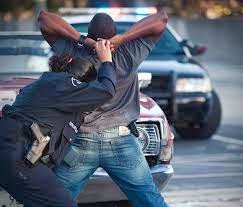 "This present-day type of systematic ethnic intolerance and governmental restrictions on specific sectors within our society are becoming somewhat reminiscent of a similar trend in 1930′s fascist Germany.
"This present-day type of systematic ethnic intolerance and governmental restrictions on specific sectors within our society are becoming somewhat reminiscent of a similar trend in 1930′s fascist Germany.
"The ideological basis of our society was founded upon the four legacies of white supremacy, male dominance, class bias and religious sectarianism.
"This upsurge in ethnic hatred and divisive behavior needs to be actively confronted and not avoided nor shrugged off. Hiding our heads in the sand instead of standing up and speaking out for correct principles and norms of mutual respect and behavior only encourages these hate-spewing bullies."
A new Center for Mexican American Studies
From Juan Tejeda comes this:
"Colegas y Camaradas: On behalf of Alamo Colleges and Palo Alto College in San Antonio, Tejas, we invite you to this special Ceremonia and Grand Opening Celebration of the Palo Alto College Center for Mexican American Studies on Thursday, March 20.
"Many colleagues have been working on this initiative for over a year and now the dream is becoming a reality. Come on out to the Southside and celebrate with us. It's free and open to the community and we'll have free food and drinks for lunch, plus some very special cantos and performances. Feel free to invite friends and familia. We give thanks for the blessing of this center and may it serve to inspire and help our children and students succeed in school and in life, for generations to come."
Denver's best Tex-Mex
During The Rick Garcia Band's performances on April 12 and 13 at Denver's Oriental Theater, you have a chance to own one of the framed posters and artwork that were displayed at Rick's Tavern!
Rick Garcia Band 24-hour line: (720) 855-8166
Es todo, hoy,
RudyG
We've just added 5thGradeReading.NET to our suite of GradeReading.NET sites! Find reviews of current fiction and nonfiction books, 740-1010L.
Check out 5th grade book reviews now.
Other sites:
This past weekend, I attended the National Science Teachers Association conference and it was a great way to meet my audience. Here are some specific things that I thought were a benefit of attending.
Know Your Audience. This is a photo of the convention floor, the display booths. It’s interesting to wander the aisles and think like a science teacher. I try to imagine which of the booths I would stop at and why—what would they offer to a science teacher of various levels (elementary, middle school, high school). And then apply that to my books: what do my books offer to the same person? It’s a great way to get a feel for the overall needs of an audience of teachers.
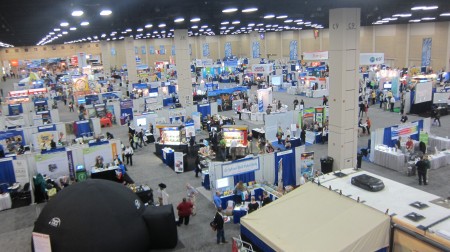
The 2013 National Science Teachers Association Convention exhibitor's hall, San Antonio, TX
Meet Your Editor. We often work long-distance with editors and a conference is a great way to meet them. Here are pictures of Sylvan Dell’s booth and staff.
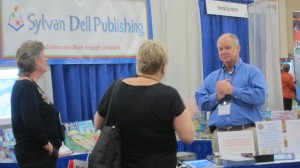
Sylvan Dell's Publisher, Lee German is a level-headed businessman who works passionately to promote and sell his author's books.
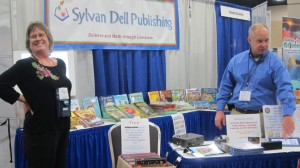
Sylvan Dell Editorial Director, Donna German. Fun, dedicated to quality--and about to become a grandmother.
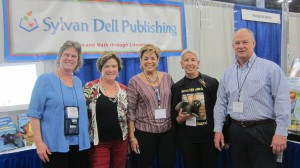
L to R: Donna German (editor), Darcy Pattison (author), Rosalyna Toth (Spanish translator for Sylvan Dell books), Terry Jennings (author), Lee German (publisher)
Meet Your Peers. On the convention floor, in sessions and just schmoozing—it’s a great way to meet other authors. We talked about everything: publishing, astronomy, advances from various publishers, Common Core, wolf snails (see Sarah Campbell’s great book), and gross things that animals do (see Melissa Stewart’s great book).
Promote Your Book. I also had a chance to promote my book on the convention floor, and in a session about the Outstanding Science Trade Books. Desert Baths—and my other titles, Prairie Storms and Wisdom, the Midway Albatross—were well received and I was fascinated to see how science teachers talked about it and how they talked about using it in the classroom. This helps me to refine how I create future books.
Network. Before the conference, I emailed various editors to see who might be attending. I wound up with an appointment with one editor and pitched an idea. The result? An invitation to submit. Hurrah!
See the Sights.
The booth across the aisle from us was Sea World. They kept bringing in live animals: bald eagle, pink flamingo, echidna, Magellan Penguins, white spotted sharks. It was a fun place to be.

Magellan Penguin from the Sea World display at the NSTA conference.
Just at dawn, when the birds were calling a greeting to the sun, we strolled by the Alamo. Remember the Alamo! And the NSTA-San Antonio conference.
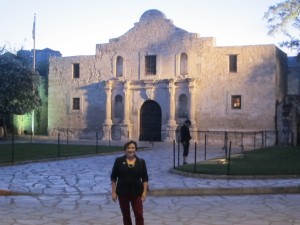
Darcy, at dawn, at the Alamo.

On April 3, 2012, San Antonio became the first major city in Texas to appoint a Poet Laureate. Mayor Julián Castro formally announced nationally renowned author and poet Carmen Tafolla as the Poet Laureate in keeping with the SA2020 goal of turning San Antonio into “a brainpower community that is the liveliest city in the nation.” The initiative applies to the Arts & Culture as well as Education vision areas. The honorary position was created to promote the literary arts and literacy within the community as well as foster a greater appreciation of the poetic arts through the reading and writing of poetry. The Poet Laureate will serve a two-year term and will commit to a minimum of three City sponsored and selected public appearances for each year of service.
"I can think of no one more worthy of this honor than Carmen Tafolla. She's not only an accomplished poet and educator; she is a homegrown talent who embodies the power and poignancy of art in our community. I am proud to call her San Antonio's first Poet Laureate," Mayor Julián Castro responded to the determination by the Poet Laureate selection committee. The announcement follows the Mayor’s State of the City address where he called for San Antonians to “be bold and invest in the city’s future” through education, early childhood education in particular.
The City’s Office of Cultural Affairs received 21 nominations representing 15 local poets. The selection committee was comprised of poetsfrom around the country: Francisco Aragon (San Francisco, CA), Catherine Bowman (Indiana), Cyrus Cassells (Texas), and Valerie Martinez (New Mexico). The application process opened in November 2011 and nominations were accepted until January 18, 2012. The committee review process took approximately six weeks.
Tafolla’s goal as Poet Laureate, she believes, is to bring the joy of literature into the daily lives of the people of this great pueblo, and to empower the expression of their own poetic voices in our young and old alike. She believes strongly that a multicultural dual-language education is one of the greatest gifts we can provide our children, and that effective family literacy is heavily dependent on the availability of stories and literature to which people can relate culturally and realistically. “Literacy and literature cannot be realistically separated if we hope to have an impact on all of our residents,” says Tafolla. “Powerful stories that reflect our reality reverberate inside us, and give us meaning. Literature cannot afford to be elitist or disconnected from the community.”
Her first solo collection of poetry, Curandera, was published in 1983, and gleaned her recognition as a master of “code-switching,” the art of alternating between formal and colloquial Spanish and English, as a literary technique. She has been called “a world class writer” by Alex Haley, and a “pioneer of Chicana literature” by Ana Castillo. Tafolla has published five books of poetry, including the award-winning Sonnets to Human Beings, translated into German in 1992, Spanish in 1994, and Bengali in 2006; the most recent collection, Rebozos, will be published in September 2012.
0 Comments on San Antonio's Mayor Castro announces nationally renowned author Carmen Tafolla as City's inaugural Poet Laureate as of 4/10/2012 11:41:00 PM

Quixote's Soldiers
A Local History of the Chicano Movement, 1966–1981
By David Montejano
"David Montejano has written a well-researched and clearly argued study of the interaction among members of different social backgrounds in San Antonio's Chicano community during the turbulent and politically creative years of the late 1960s and early 1970s. He has augmented extensive archival research (especially in the papers of Congressman Henry B. Gonzalez) with effective use of secondary works by other sociologists and historians and his own field work. This book will be of interest not only to historians of Mexican American urban life and Chicano struggles for civil rights, but also to anyone interested in the politics of the Vietnam War era."
0 Comments on New From UT Press as of 1/1/1900
So last month I went to San Antonio for a writing retreat with six members of my YA writer critique group (writers Debby Garfinkle, Jody Feldman, Martha Peaslee Levine, Kate Tuthill, and Mary Beth Miller.) The group is called YAckers—which says a lot about what we do when we get together. We meet online mostly, but try to meet in person at least once each year. It is a gathering of Literary Goddesses in search of the muse, and involves prodigious eating, drinking, visiting, sightseeing, shopping, whining, bragging, and, yes, some writing and critiquing.
We stayed in a bed and breakfast (Alamo Street Victorian Inn) and had the whole place to ourselves most of the time, except for the owners and a handyman named Paul who buzzed around us like a yellow jacket at a late summer
picnic.
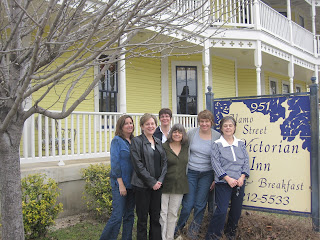
Novelists have special challenges when it comes to seeking effective critique. Many critique groups read a chapter a month. I belong to a couple of those. They are great resources, but we never get even halfway through one of my novels in a year’s time.
Also, it’s an odd way to read a novel. There’s no opportunity to enter the dream of fiction, and it’s easy to forget what’s going on, month to month. If your readers can’t remember who Jason is, is it because you didn’t do your job as a writer, or because it’s been two months since Chapter 3?
Each chapter can work perfectly well, but the entire story arc may be flawed, the characters erratic and inconsistent, and the ending unsatisfying. If nobody ever reads more than a few chapters, you’ll never know.
So for our retreats, we submit novel-length works to the group ahead of time, and spend several hours discussing each piece submitted. The Goddesses are smart, savvy, experienced readers who work in unrelated genres. And I came away from my personal critique session saying, “Why didn’t I see that? Of course!!”
One of Many YAckers Food Opportunities at Boudreau's
It’s a safe environment in which to vent, seek wisdom, and ask the “Am I crazy?” questions. What happens in San Antonio stays in San Antonio.
On the shopping front, we are very good at encouraging each other’s vices. Martha bought jewelry, Debby and Jody bought art. I found a nifty silver wrist cuff in a shop at LaVillita. When I showed it to my fellow YACkers, they said, “You have to buy two!!” You see, there’s a character named Cuffs in my current fantasy series who wears magical silver bracelets on his wrists.
Author appearances!! School visits!! Tax deductible!! they said. And, You know you want to.
So nothing would do but I went back into the store and bought a second cuff (and

Posted on 8/14/2009
Blog:
Laurasmagicday
(
Login to Add to MyJacketFlap)
JacketFlap tags:
family,
new orleans,
funny,
mx,
tx,
la,
san antonio,
2009 road trip,
road music,
cut and shoot,
Add a tag
After a doing a little shopping in New Orleans and visiting some of the uber-scary places we saw the night before,


Old Ursuline Convent
we hit the road for Cut and Shoot, TX to meet up with my brother and his family at my sis-in-law's family picnic celebrating the 60th anniversary of her Aunt and Uncle.

Awesome Elvis Impersonator

We had a great time. All her relatives were so sweet to us, so welcoming, and there were at least a hundred people there. Fun to catch up with all that's been going on with Mike and his family. It was Memorial Day weekend, and, in honor of our fallen soldiers, those assembled stood and sang, "Dixie." I only knew some of the words. Such an amazing moment. A Southern moment. Mx had to leave though, the emotion of the day brought tears to her eyes. Her cousin Cody and his good friend David had called a day or two before to let her know that they were being deployed to Afghanistan that weekend.
After the wedding we crashed in our beds in San Antonio, we stayed at The Omni San Antonio, but were barely there twelve hours because we were headed off to Carlsbad, New Mexico the next day. On our pillows were little oval wooden boxes with tiny dolls inside and a note that read:
"Legend has it that the Yanaguana Indians, a peace-loving tribe of native San Antonians, extended their hospitality to Spanish settlers by presenting them with these handcrafted worry dolls. According to tradition, by transferring one worry to each doll before bedtime, and placing them under your pillows your worries would disappear by dawn's light."
We were selling our our house at the time, so I transferred my worries about the sale and Cody's safety to my little dolls knowing full well that the Spaniards of long ago had similar concerns about shelter and survival. Timeless worries, I guess.

 This is what I had: New shoes and a turquoise dress. My head filled with the fine craftsmanship of my fellow would-be ALAN panelists. My camera, for I've always wanted to see San Antonio. Two books for the plane. A bag of M&Ms.
This is what I had: New shoes and a turquoise dress. My head filled with the fine craftsmanship of my fellow would-be ALAN panelists. My camera, for I've always wanted to see San Antonio. Two books for the plane. A bag of M&Ms.
This is what happened: The computers aren't working well at the A 12 terminal of the Philadelphia airport—Boston flight posted on the San Antonio screen, those in charge scratching their heads and asking each other the sort of questions we passengers had hoped to ask them. An inconvenience, only.
Up next, though, the plane I am to take is three-quarters boarded when somebody mentions a Whoops. Whoops as in, Um. We're sorry. This plane isn't actually headed southwest. It's headed for New York.
(The woman in charge running across the tarmac, gathering the passengers who must now gather their bags, saying, I'm sorry. We got that wrong.)
Afterward, another whoops. Whoops as in, Your plane—the one that is actually headed southwest—is in maintenance. We don't know what's wrong. We don't know when it will be fixed. Give us an hour. Whoops as in another hour goes by, and now the terminal printers don't work and the sign still reads: Boston 9:50, even though by now it's 11 o'clock and all we want to do is head southwest. And now the word goes out that Maintenance is still having trouble with the would-be (ersatz?) plane and they don't know when they'll get it fixed.
There were five us headed for San Antonio. One by one we began to peel off. Too much of this didn't feel right for any of it to be right. That was the decision we singularly made.
This is how it went. This is why I am home and not in San Antonio, at the ALAN conference, where I had looked so forward to being.
This is what I thought as I drove home from the airport, where I'd spent the past five hours: I love my husband. I love my son. I love my father and family. I love my tiny house. I love my friends and the books on my shelf.
I love this life.
I'm very disappointed that I'm not in San Antonio. But I'm still here, alive to the cold brisk air. With a pair of new shoes I may someday have a place to wear.
René Colato Laínez
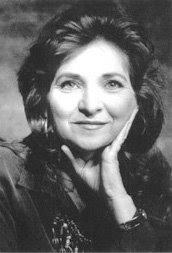 Hola Carmen, thank you for this interview for La Bloga.
Hola Carmen, thank you for this interview for La Bloga.
Who inspired you to write?
My mother was a person with very little formal education, but a great ear for a story, and a great memory for people's stories. My grandmother was a storyteller, as were several aunts. And SO, it turns out were my GREAT-grandparents. Listening to the stories of my familia and my barrio was where I first learned to love the art of storytelling, and to respect the power of a story... orally, with all the magic of unwritten centuries behind me... Stories get more powerful when they are refined through the telling, generation after generation....
I was very, very young when I began to dream of writing stories down, preserving them, polishing them. They were our history, and they were our alma.
-As a child what was your favorite book?
We didn't have a lot of books at home, a Spanish-language Bible, a hymnal, a book about medicine (I thought! It was called La Santa Doctrina, so I figured it had to do with Doctors and Medicine...) But when I was about 5, my parents started one of these a dollar-a-month Childcraft Series offers, and the first volume was "Childhood Verses, Rhymes, and Fables." I can STILL see those pages and remember the stories! So, between that and the Old Testament and the leyendas told orally, I had plenty of exciting stories to start off with. When I was 10, the city finally put a library on the "West Side" (the Mexican side) of town, and then my Mom would walk me weekly to check out five books, the maximum they'd let me check out at a time. I never discovered Dr. Seuss or Madeleine L'Engle or Garcia Marquez or Winnie the Pooh till I was in college! And then I fell in love with books all over again.
-Tell us about your new books.
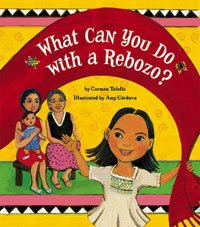
I have two children's books and one adult book out this year.
What Can You DO with a Rebozo? (Tricycle, 2008) is a colorful, imaginative picture book beautifully illustrated by Amy Cordova and targeted at children under 6. It celebrates an icon of Mexican culture through the eyes of a little girl who sees its versatility, but invents some uses of her own! I want to show little girls (and boys!) that they can use one thing for many purposes, and that sometimes the funn---iest games come from using our own imagination!
 Then, That's Not Fair: Emma Tenayuca's Struggle for Justice, co-authored with Emma's niece, Sharyll Teneyuca, is a picture book biography for children 6 and up, based on the courageous Latina civil rights leader from the 1930s, who at the age of 22, organized and led 12,000 pecan shellers in a strike that represents the first successful mass action in the Mexican-American struggle for political and economic justice. Our adult biography on Emma is nearing completion, but this children's book is the first book ever published on her, and it is a really beautiful volume by Wings Press, illustrated by Terry Ybanez and designed as a tribute to those brave pecan shellers who were starving to death and still had the courage to hope for a better world for their children. Even the endpapers are pecan-colored!
Then, That's Not Fair: Emma Tenayuca's Struggle for Justice, co-authored with Emma's niece, Sharyll Teneyuca, is a picture book biography for children 6 and up, based on the courageous Latina civil rights leader from the 1930s, who at the age of 22, organized and led 12,000 pecan shellers in a strike that represents the first successful mass action in the Mexican-American struggle for political and economic justice. Our adult biography on Emma is nearing completion, but this children's book is the first book ever published on her, and it is a really beautiful volume by Wings Press, illustrated by Terry Ybanez and designed as a tribute to those brave pecan shellers who were starving to death and still had the courage to hope for a better world for their children. Even the endpapers are pecan-colored!
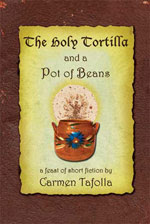
And, just last month, Wings released a collection of my short stories, which I just presented at The International Conference on the Short Story in English, held in June in Cork , Ireland . The title The Holy Tortilla and a Pot of Beans, a feast of short fiction, kind of says it all – it’s about the holy and the miraculous, as well as about the mundane, most common, underappreciated blessings, like a pot of hot, homemade beans.
- Where did you get the idea for What Can You Do With A Rebozo? Do you have many rebozos at home?
Rebozos are one of my most useful clothing items. I live in San Antonio, where the weather might be 100 degrees and sweltering one minute, then walk into an air-conditioned building and just freeze till you're blue. Or it might drop 40 degrees in three hours. I also travel a lot, so a rebozo is a very useful and versatile item to help me deal instantly with weather changes and different levels of formality. It has served me as a coat, a muffler,a fan, a head scarf, PLUS, it rolls up into a tiny corner of the briefcase! I have three BIG boot boxes at home, each with a different range of colors!
In 1992, 500 years after America discovered Columbus lost on a beach, my publisher was looking for art for the front cover of my upcoming poetry book, Sonnets to Human Beings. I recommended Cata Garate, who had a whole series of oil paintings of women in rebozos. When the book came out, Sally Andrade was so stunned by the cover she asked if U.T. El Paso could exhibit Cata's whole series together with poems of mine. We did, but then one thing led to another and soon, Cata and I were at work on a coffee table book combining art, poetry, and the story behind this universal symbol of Mexican womanhood. That book will be out soon from Wings. But the idea of the rebozo's versatility soon had me "cooking on" a children's picture book and developing a spunky little Chicanita protagonist, 4 years old, who could come up with crazy, imaginative uses for her Mom's rebozo! What Can You DO with a Rebozo? just came out of Tricycle this spring, sparked a series, and the follow-up book What Can You DO with a Paleta?, is due out from Tricycle Press in Spring of 09.
- The Holy Tortilla and a Pots of Beans is full of culture and magical realism and each story tells a message. What was the selection process for the stories included in the book?
In this very blase, over sophisticated, materialistic world, where emotions are corny, human decency is looked down on as "political correctness", and everything is assessed in "measurable" terms, I wanted an emphasis on those things that lie BENEATH the skin, and outside the realm of the price tag. I wanted to select stories that filled that dimension between the stark simplicity of the Holiest things we encounter to the absolute magic of the everyday objects around us. That's why the title is not just "The Holy Tortilla" (too pious and above us) but also includes a normal, everyday Pot of Beans...
If the stories can help elevate to the holy the simple, daily values, customs, strength and beauty of nuestra gente, then I'll have done justice to the people, the everyday readers to whom this book is dedicated.
-You write for many genres. What is the difference between writing for children and for adults?
Actually, children are more demanding readers. Adults will kind of assume that SOME place in the book, there'll be something good that they might appreciate or learn from. But children-- if you lose them on even ONE page, they want to get up and go do something else. So, writing for children demands distilling every word, polishing every action, eliminating ALL excess baggage. It's almost harder than writing poetry!! But the reward-- is in the power and authenticity of what's left. If you reach children, (and I expect good children's lit to be timeless, so I want to reach children now and three generations from now), then you've hit something authentic.
- What is your message for inspiring writers?
A very long time ago (I must have been 10 or 12 years old) someone told me that to get a PhD, you had to write a book called a dissertation, and it had to be on a topic NO ONE had ever written on before. I immediately felt impatience and despair, and thought that if I didn’t hurry up and get grown up fast, like tomorrow, all the topics would be used up and there wouldn't be anything left to write about! For a long while, I thought that was true, lamented the fact that by the time I grew up, all the good storylines would be taken, all the topics explored, all the interesting devices invented already. Boy, was I naive!
Now, I tell young writers, there is NO ONE on the face of the earth who can see the world in quite the same way you do, nor who has had quite the same combination of experiences and emotions. You are unique, your voice is a necessary part of the puzzle, without which we are deprived of the full richness of the human experience. So don't worry about how you compare to others, don't follow anyone else's example, nor anyone else's rules, invent your own rules, and then master them! It is the essence of art, to reach deep into what comes from your own soul, and then turn yourself over to it, follow, explore that path. Learn from others, but also learn from that quiet voice whispering to you, that knows when you have not quite written it as well as you know it could be written. Write who you are, but trust yourself, and your art, to grow beyond your own boundaries.
For more about Carmen, visit her website www.carmentafolla.com
Meet Carmen This Sunday
The Museo Alameda
Tricycle Press
and MANA de San Antonio
invite you to join them in
CELEBRATING
“What Can You DO with a Rebozo??”
The Museo Alameda invites the public to a Family Day!
Children’s Costume Contest and Book Party
for Carmen Tafolla’s latest children’s book,
“WHAT CAN YOU DO WITH A REBOZO?”
Beautifully illustrated by award-winning artist Amy Cordova, this picture book aimed at 3-5 year-olds, celebrates the versatility and practicality of this icon of Mexican womanhood, and encourages young children to explore the delightful territories of their own imagination.
Sunday, August 3, 2008
12-4 pm
101 S Santa Rosa Ave
San Antonio, TX 78207
(210) 223-5820
Hands-on activities for Children, 12-1, and 1:30-4:00
1:00 Program:
*Foklórico dances by the famous Champion family dancers *a storytelling session by award-winning author Carmen Tafolla
*a fun demonstration by San Antonio’s Hermanitas, showing styles for the elegant, practical, and fun-costuming uses of rebozos, for adults and children
*Children’s Costume Pageant & Contest (age 10 and under) with prizes for
-The Most Creative Use of a Rebozo,
-The Silliest Use of a Rebozo,
-The Most Adventurous Use of a Rebozo,
-the Most Colorful Use of a Rebozo
-the Most Elegant Use of a Rebozo
-the Scariest Use of a Rebozo
Costume Contest award-winners will each be given a free copy of the beautiful hard-cover book. One lucky family will receive the Grand door prize of a four-book collection of books by Carmen Tafolla, including her brand new collection of short stories, The Holy Tortilla and a Pot of Beans.
1:45 Presentation of Contest Awards
2- 4 Booksigning by Carmen Tafolla
All exhibits open to the public.
Books by Carmen Tafolla available in the Museo Gift Shop
Macondo Libre
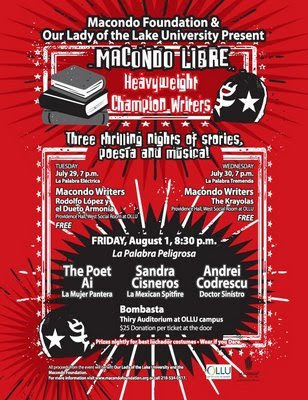
If you missed last night La Palabra Eléctrica, come tonight for another great Macondo night, La Palabra Tremenda. In the tradition of Mexican Lucha Libre where good conquers evil, our writers fight for political and social issues. In Macondo Libre, writers will showcase fighting moves that will take your breath away!
Don’t miss the ultimate challenge, la Palabra Peligrosa, a literary fundraising event where nationally acclaimed poets and writers wrestle the truth out of the official story and reclaim it with a night of powerful readings and music. This dramatic lucha poetry slam will include performances by the poet Ai; poet, writer and NPR commentator Andrei Codrescu, Sandra Cisneros and musical performances by the father/son team George/Aaron Prado, the Krayolas and other special guests. All proceeds from the event will benefit Our Lady of the Lake University and the Macondo Foundation. At last, the word wrestlers are here. ¡Que viva Macondo Libre!
La Palabra Tremenda
Featuring: Macondo Writers and Special Community Guests
Wednesday, July 30, 2008
San Antonio, Texas
Our Lady of the Lake University
Providence Hall, West Social Room [PWSR]–the Red Room–at OLLU at 7 p.m. Admission: Free
Readers:
Carolina de Robertis
Ignacio Ramos Magaloni
Tatiana de la Tierra
Amelia ML Montes
Angie Chau
Ben V. Olguín
Erin Bad Hand
ire'ne lara silva
Leslie Larson
Lorraine M. Lopez
(15 minute intermission - The Krayolas)
Maria Limon
Miryam Bujanda
Pat Alderete
René Colato Laínez
Rosalind Bell
Trey Moore
Wendy Call
La Palabra Peligrosa
Featuring: the poet Ai, Andrei Codrescu and Sandra Cisneros
Friday, Aug. 1, 2008
San Antonio, Texas
Our Lady of the Lake University
OLLU at Thiry Auditorium 8:30 p.m.
Admission: $25 Donation per ticket at the door
Macondo Foundation
The Macondo Foundation is a not-for-profit organization that organizes and hosts an annual workshop for professional writers. It originally began as a writing workshop around the kitchen table of poet and writer Sandra Cisneros in 1998. Since then the workshop rapidly grew from 15 participants to more than 120 participants in less than nine years. The foundation also has a writer in residency program and continues to grow in its outreach to writers. As an association of socially-engaged writers united to advance creativity, foster generosity, and honor community, the Macondo Foundation attracts generous and compassionate writers who view their work and talents as part of a larger task of community-building and non-violent social change.
For more information about the Macondo Foundation check our web site www.macondofoundation.org.
Los esperamos








































Oh to be back in San Antonio, specifically Boudreau's! I wonder if they export their guacamole ....
Kate